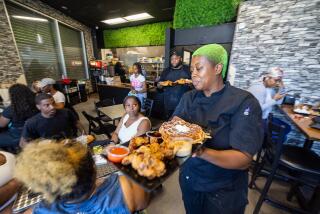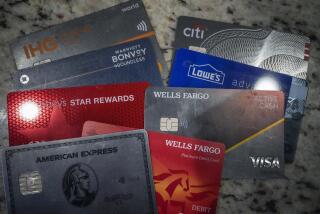Sensible spending’s downside
- Share via
WASHINGTON — The continuing decline in consumers’ use of charge cards and other forms of credit reflects an underlying weakness in the U.S. economy that most of the government’s recovery plans fail to attack head-on. And it suggests a fundamental shift in the way Americans save and spend that is likely to act as a drag on the economy for at least several years.
Beset by rising unemployment, declining wages and persistent credit-tightening by banks, consumers are pulling back. Although some economists welcome the trend after years of open-handed spending, the belt-tightening is almost certain to have a negative effect on the U.S. economy, in which about 70% of gross domestic product comes from personal consumption.
A government report issued Wednesday shows that consumer borrowing is still falling. The monthly credit balance numbers from the Federal Reserve are considered volatile, and May’s decline was much smaller than earlier this year. But analysts said the trend was likely to remain downward.
“Consumers were living in a fantasy world for much of the last decade,” said Lyle Gramley, an economic advisor with Soleil Securities Corp. and a former Fed governor. “The financial crisis has been an enormous wake-up call.”
The contraction in consumer borrowing and spending may have been inevitable.
Many Americans had been using their credit cards and years of home equity borrowing to cover expenditures that exceeded their incomes. The personal savings rate, which had been at or near double digits during much of the 1970s and ‘80s, dropped to 1% or lower starting in 2005.
But over the last two years, personal income has been stagnant or declining. The recession has wiped out 6.5 million jobs. Millions more workers are fearful of being laid off.
Moreover, the home equity borrowing that many families have used to cover expenses has been choked back by the credit crisis and the plunge in home values. Average home equity per household was estimated at just under $50,000 earlier this year, less than half of what it was in early 2006.
After falling sharply last year, personal spending showed signs of leveling off this spring as government payments and tax cuts put more cash into Americans’ pockets.
But consumer expenditures remain soft, especially for automobiles and other big-ticket items; many people are clearly intent on socking away money. The personal savings rate jumped to 6.9% in May, the highest in 15 years.
“We have the biggest change in the history of consumer spending” in the U.S., said Howard Davidowitz, chairman of Davidowitz & Associates Inc., a national retail consulting and investment banking firm. “The consumer is wrecked.”
That could show up again today when chain-store sales are reported by the International Council of Shopping Centers. Sales fell 4.6% in May.
Scared into saving as much as possible, the statistics indicate, shoppers are shunning high-end retailers in favor of discount stores such as Wal-Mart and Family Dollar.
“The consumer wants cheap, cheap, cheap,” Davidowitz said. “The consumer is focused on price and dollars. What else could they do with these job losses?”
Meanwhile, lenders remain cautious about extending new credit. The Fed report Wednesday said credit card and other revolving loan balances fell in May at an annualized rate of 3.7%. Analysts said that reflected weaker consumer appetite for credit but also banks’ unwillingness to extend it at a time when many people owe more on their homes than they are worth and are struggling to make debt payments on time.
The American Bankers Assn. reported this week that credit card payments and other types of consumer loans that were more than 30 days overdue rose slightly in the first three months of the year, to 3.23% of all such accounts.
Credit card delinquencies reached their highest rate since 2005, with 4.75% of accounts more than 30 days overdue, driven largely by job losses.
James Chessen, the organization’s chief economist, said many consumers are trying to pay off their debts as they worry about the bleak economy. That is leading to less spending.
“There’s greater savings because there’s greater uncertainty about what will happen to jobs and income over the next couple of years,” Chessen said. “It’s going to be a slow climb out of this hole we’re in.”
Banks also are being more careful about the terms of consumer loans and extensions of credit, he said, further reducing consumers’ ability to spend.
“Banks have to weigh the likelihood of not getting repaid, and the risk of lending today is much greater than what it was several years ago,” he said.
--
More to Read
Inside the business of entertainment
The Wide Shot brings you news, analysis and insights on everything from streaming wars to production — and what it all means for the future.
You may occasionally receive promotional content from the Los Angeles Times.











